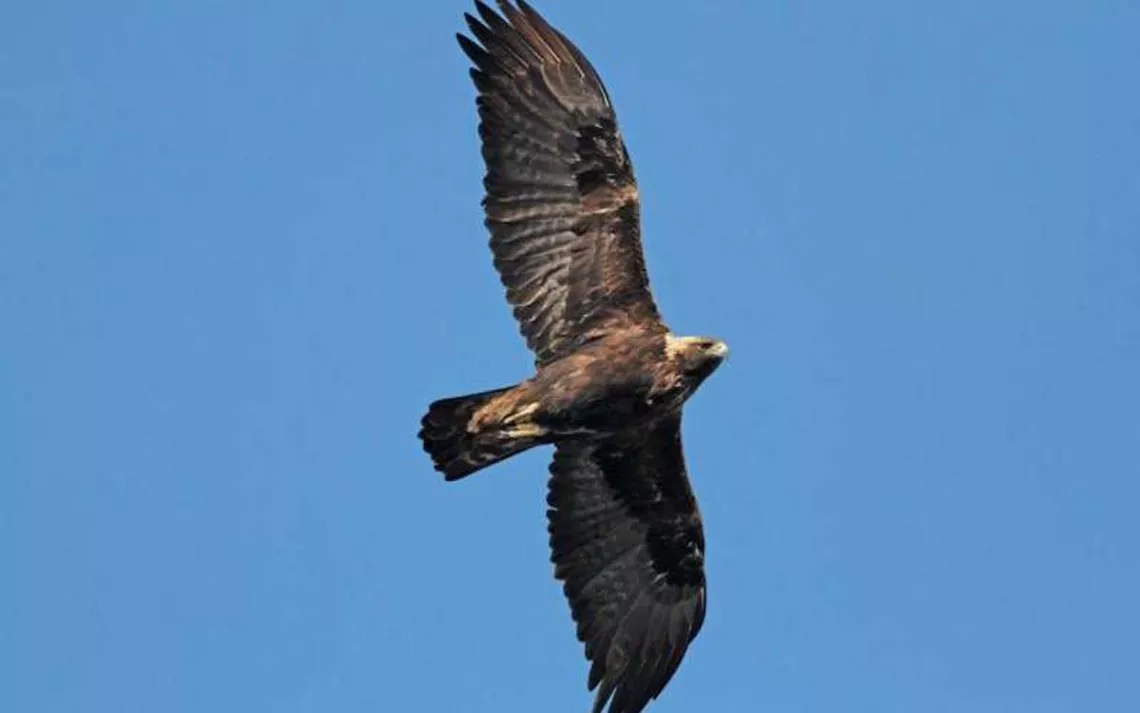When Young Eagles Ride the Winds
Adult golden eagles migrate through rough weather; younger birds might know better

Photo courtesy of D. Brandes
There’s a longtime assumption about bird migration: The more years a bird follows the long path from its wintering grounds to its northern breeding territory, the more efficient it becomes. That’s what USGS research wildlife biologist Todd Katzner expected to find in the reams of data he’s collected from the small migratory population of golden eagles, Aquila chrysaetos, in the eastern United States. Over the last decade, Katzner and his collaborators have captured and attached trackers to about 90 eagles, mapping their movements down to the minute. “One of the things we know from other studies and projects is that there’s this typical relationship where as birds get older, their migratory performance improves,” says Katzner. “They learn how to fly more quickly, in a straighter line, and how to use updrafts. That’s established ecology and works in general for all birds.”
But when undergraduate research fellow Adrian Rus crunched the numbers, the team found something very different. The juveniles flew faster and in straighter lines than the adults, which flew more slowly, taking more circuitous routes. It was essentially the opposite of every other study out there. “It was counterintuitive,” says Katzner, coauthor of the study in the journal The Auk: Ornithological Advances. “It means all that experience might not be helping them out like we thought. They were moving slower than the younger inexperienced eagles.”
When the team looked closer at the numbers and correlated the eagles’ movements with the seasons and weather data, they began to understand the discrepancy. It turns out that juvenile eagles, which usually do not begin breeding for five years, and breeding adults face very different pressures. Adults need to make it to their breeding range as soon as possible in order to claim their nests and guard their territories.
This means heading north in February and March when weather conditions aren’t the best. Sometimes that means flying through challenging winds, clouds, and cold weather. Warm weather creates thermal updrafts that lift eagles and other raptors high into the air, allowing them to glide long distances. But in late winter, there are few thermals, so the eagles often rely on orographic updrafts, or winds forced upward by ridgelines. That means adult eagles follow ridges through the Appalachians instead of taking a more direct route to nesting sites in Canada.
The younger eagles, however, don’t have the same pressures to get north to protect their territories. Instead, says Katzner, they wait later in the season until the weather turns nice and they can glide north on the thermals. They tend to sit tight on days with bad winds or clouds. While the data shows that the adults and juvenile eagles covered roughly the same amount of territory per day, the juveniles moved much more quickly, which gave them more time to hunt along the way.
Besides saving energy, starting later in the spring offers younger birds other advantages. “If a young bird gets up there too early, they are going to get beat up a lot by adults protecting their territory,” says Katzner. “There’s a lot of incentive for showing up late. They know food will be available and the days are longer and a little more pleasant.”
Emily McKinnon, who studies birds at the University of Manitoba, conducted a similar migration study on wood thrushes, Hylocichla mustelina, which winter in Central America and migrate to the eastern United States to breed. She says that while the migration efficiency of juvenile eagles might be better than the juvenile thrushes', the pattern is very similar. “Like Katzner’s team, we found that younger birds and first-time spring migrants departed later than older birds,” she says. “That’s really key. They ended up arriving later at the breeding site.”
Unlike eagles, thrushes do breed after their first migration, but they are the low bird on the totem pole; they often miss out on the best breeding sites and sometimes don’t find mates. “The overall pace of the young birds was slower. They were taking their time focusing on survival, going more slowly and stopping more frequently,” says McKinnon. “They can’t compete as well once they get to the breeding ground, so they’re just fattening up in advance of breeding. That’s how we saw it.”
It’s likely the juvenile eagles are following a similar strategy, but the strong thermals and tail winds give them a little speed boost. It may not just be eagles that get some help from a later start date. “We’ve figured out something other people haven’t,” says Katzner. “It wouldn’t surprise me if it applies to other raptor species as well.”
 The Magazine of The Sierra Club
The Magazine of The Sierra Club



